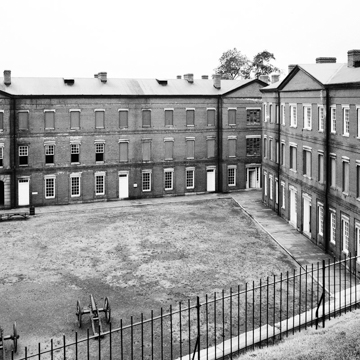As early as 1794, the architect Pierre-Charles L'Enfant recommended a fort on this muddy island to protect Philadelphia from attack. The War of 1812 confirmed that forts needed to lie at a considerable distance from the cities they defended, and an ambitious series of national fortifications was planned. A fort in the traditional “star” shape was built here (1816–1827), but its foundations shifted in soggy ground, and it was demolished after a fire in 1831. A second fort was begun but was damaged by a flood, and all work stopped during a lawsuit over ownership of the island. Clearing, foundation work, and pile driving for the present edifice took place in 1848–1852, and stone walls began to rise, with outer facings of Quincy, Massachusetts, granite. Work dragged on until 1868, by which time the island had served as a fetid detention camp for thousands of Confederate prisoners, with more than forty buildings surrounding the fort. All evidence of this sprawling wartime facility was later buried under dredge spoils. Fort Delaware was modified during the Spanish-American War by the insertion of a Three Gun Lift, a hulking concrete-with-sand-core battery to house disappearing guns. One of the two original Officers' Quarters and half of the barracks were demolished. The fort was abandoned after World War II, having never fired a shot against an enemy. Vandals worked the place over even after the state park was established in 1951. Professional restoration and interpretation of the imposing ruins began in 1995, and 40,000 tourists now visit annually. Prison barracks have been re-created; staff offices, mess halls, supply room, and officers' quarters have been restored; and fiberglass replica cannons added. There has been talk of over-restoration by eliminating the historic, concrete additions of the 1890s.
The six-acre fort consists of five polygonal bastions at the corners, with three-story ramparts between. The outer granite wall, or scarp, rises steeply above a water-filled ditch. One enters over a drawbridge and through a pedimented sally port with massive doors. Inside is a grassy parade ground. Guns were mounted inside the walls as well as on the terreplain on top, which offers sweeping views of the river. The gun emplacements have iron rails in the floor (along which the carriages swiveled) and embrasures cut into the massive stone walls. Heavy, yet graceful, brick arches (in utilitarian English bond) form complex geometries, as do circular stairs of granite. The whole comprises a fascinating labyrinth of dark, dripping, echoing corridors with slimy walls. Fort Delaware is one of the state's most significant buildings, its rugged construction insuring exceptional preservation in spite of the vandalism. A must-see for any Civil War buff, it is far better preserved than the more famous, war-shattered Fort Sumter at Charleston.




















